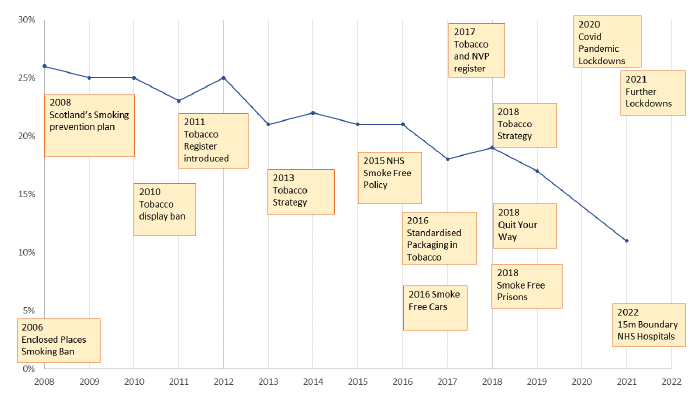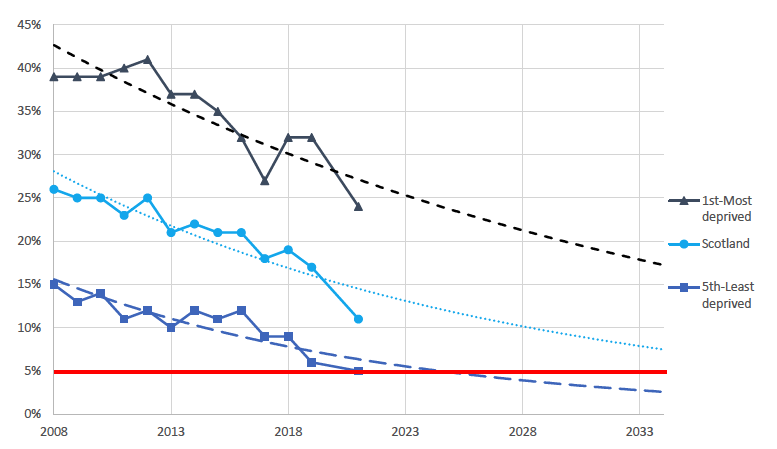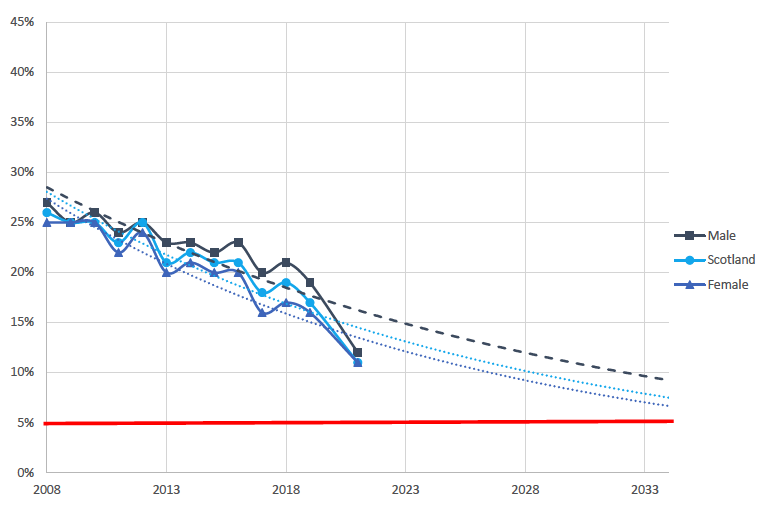Tobacco and vaping framework: roadmap to 2034
This focuses on both tobacco and vaping and sets our direction to 2034. It also includes the first implementation plan, which will run until November 2025.
3. Tobacco Control Policy in Scotland – Background
Since the Scottish Parliament was established in 1999, there has been a range of tobacco control policies introduced both in Scotland and across the UK:
- work on UK-wide legislation to ban tobacco advertising in 2002;
- implementation of Scotland's historic smoke-free legislation in 2006;
- increase in the age for tobacco sales from 16 to 18 in 2007;
- overhaul of tobacco sale and display law, including legislation to ban automatic tobacco vending machines and a ban on the display of tobacco and smoking-related products in shops;
- establishment of the first Tobacco Retail Register in the UK in 2011;
- comprehensive awareness-raising campaigns; and
- record investment in NHS smoking cessation services helping hundreds of thousands of people to attempt to quit smoking.
However, despite these interventions smoking deaths remained high and there was a recognised need to introduce a dedicated tobacco control strategy.
3.1 2013 Strategy
In 2013 the Scottish Government launched 'Creating a tobacco-free generation: A Tobacco Control Strategy for Scotland'[8]. It contained the ambitious aim of making Scotland tobacco-free (population smoking prevalence of 5% or less) by 2034 (hereafter referred to as the 2034 target).
The Strategy sets out a challenging 5-year programme for tobacco control. It brought together the Scottish Government, Local Authorities, NHSScotland and the third sector, both individually and in partnership to progress our tobacco-free ambition.
Forty-six actions were set out in the strategy to work towards achieving this goal.
This was a world leading approach and set the direction from which subsequent Tobacco Control Polices were set.
This initial 5-year strategy focused on three themes:
- Prevention - creating an environment where young people choose not to smoke;
- Protection - protecting people from second-hand smoke; and
- Cessation – helping people to quit smoking.
The role of inequalities was recognised with the explicit recognition that effective action to reduce smoking prevalence demanded a focus on those communities at greatest risk of unequal health outcomes.
One of the best summaries of what we have achieved during the 2013 Strategy can be found in the Review of "Creating a tobacco-free generation: A Tobacco Control Strategy for Scotland" published by NHS Health Scotland in partnership with the Public Health Evidence Network and the Scottish Collaboration for Public Health Research and Policy.[19]
These actions can be summarised as:
- Reduced the visibility of cigarettes and tobacco products from retail through making the display of these products an offence;
- Ended the sale of cigarettes and tobacco products from vending machines;
- Ran public campaigns on the dangers of second-hand smoke;
- Introduced (non-legislative) smoking policies for NHS Health Boards intended to make all hospital grounds smoke-free;
- Supported the introduction of law to make smoking in a car with a child an offence, to help further protect children from the known harms from exposure to second hand smoke;
- Led the way on the introduction of standardised, plain packaging for all cigarettes sold in the UK;
- Introduced law to restrict the age of people to which vapes can be sold, as well as the age at which people can sell vapes;
- Introduced compulsory registration of retailers selling vapes; and
- Ended the sale of vapes from vending machines.
These actions alongside the UK-wide implementation of the European Directive on Tobacco Products[20] made up a comprehensive package of measures which help prevent children from taking up smoking and protect people from the harms of second-hand smoke.
3.2 2018 Plan
The 2018 Tobacco Action Plan "Raising Scotland's tobacco-free generation: our tobacco control action plan 2018" was launched by the Scottish Government in June 2018 superseding but building on the 2013 Strategy.[21] This five-year action plan set out further interventions and policies to help reduce the harms from tobacco in Scotland. The actions were spread across four themes:
- informing and empowering through raising awareness;
- encouraging healthier behaviours;
- improving services; and
- providing protection through regulation.
Progress on actions has been slower than anticipated due to the wide-scale disruptive effects of the covid pandemic. This heavily affected our ability to improve services and create new legislation.
Progress on actions (including legacy actions from the 2013 strategy) can be summarised as[22]:
- Continued to provide funding for tobacco control budgets in Scottish Government, Cessation Services in Health Boards and to support enforcement by Trading Standards officers in Scotland across the lifetime of the plan;
- Introduced law to create a 15m smoke free boundary around all NHS hospital buildings;
- On 30 November 2018, having developed a service specification all prisons in Scotland became smoke free, where tobacco is banned and is a prohibited item[23];
- Ran community pharmacy campaigns to support cessation awareness;
- Continued to support the Quit Your Way service including the "Getting through 72 campaign";
- Undertook and published a review of cessation services to understand how the pandemic had affected services and to look for ways to improve referral pathways;
- Supported on-going UK-wide work on pack inserts to support cessation;
- Continued to work with Trading Standards officers in Scotland over illicit trade and enforcement activities;
- Held a consultation and published the consultation analysis report on Vaping products – proposing a tightening of rules on advertising and promoting; and
- Published a report on Vaping - understanding prevalence and trends among adults and children: research[24].
We have also supported on-going UK wide work on the Smoke Free Generation, consultation which launched on the 12 October 2023.[25] This is a significant step forward in tobacco and vape control across the UK. The consultation asks for views on proposals to raise the age of sale of tobacco year-on-year so that a child born in 2009 can never legally purchase tobacco products. It also includes several proposals on youth vaping including:
- restricting flavours;
- regulating point of sale displays;
- regulating packaging and presentation;
- considering restricting the supply and sale of disposable vapes;
- whether regulations should extend to non-nicotine vapes; and
- taking action on the affordability of vapes
One incomplete action across both plans was the commitment to complete an audit of our compliance under article 5.3 of the World Health Organisation Framework Convention on Tobacco Control. This was heavily impacted by the covid pandemic and the decision was taken to prioritise progress on actions such as the development of the smoking outside hospital buildings legislation and the cessation review.
Scotland remains firmly committed to article 5.3, and improving transparency and accountability (see section 5.5).
Figure 1 shows the range of policy interventions in Scotland alongside adult smoking rates in Scotland.

3.3 Continued effort required
As Figure 2 and Figure 3 demonstrate, to reach our goal of 5% prevalence by 2034, more work needs to be done because current prevalence trends suggest that while we are on the general flightpath to meeting that goal (with further action) at an overall population level, inequalities remain high.


Contact
Email: Tobaccocontrolteam@gov.scot
There is a problem
Thanks for your feedback